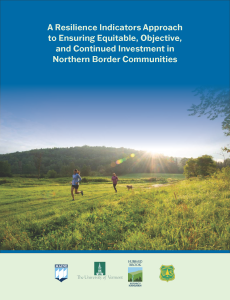New Report: Ensuring Equitable and Continued Investment in Northern Border Communities
 Ensuring Equitable, Objective, and Continued Investment in Northern Border Communities
Ensuring Equitable, Objective, and Continued Investment in Northern Border Communities
Daigneault, A., Daigle, K., Garlick, S., Hamshaw, K., Lavallee, A., Niles, M., Weiskittel, A., Whitehouse, C., and Woodall, C., 2023. A Resilience Indicators Approach to Ensuring Equitable, Objective, and Continued Investment in Northern Border Communities. Final Project Report.
Orono, ME. Collaborators from the University of Maine, The University of Vermont, Hubbard Brook Research Foundation, and the USDA Forest Service have released a report aimed at understanding community resilience in the Northern Border region, particularly following the pandemic. The federally designated region, encompassing areas of Maine, New Hampshire, Vermont, and New York that border Canada, is more likely to have higher levels of unemployment, population loss, and lower incomes than neighboring areas. The goal of this report is to address these issues by providing objective metrics that can help align strategic federal and state investments in the region.
“Our study demonstrates the utility of using objective data to understand resilience trends at the community scale,” said Dr. Adam Daigneault of the University of Maine, who led the study. “The abundance of forestland in the region can be a blessing and a curse. While forests provide a range of ecosystem services like fiber, recreation, and clean water to local communities, we also found that highly resource-dependent communities can be less resilient than other parts of the region.”
The report builds on three key objectives: (1) development of quantitative indicators of socioeconomic resilience, (2) generation of baseline data about the community’s views on assets and challenges, and (3) determining how to think about ecological data in relation to community resilience. A community’s resilience can be measured by its ability to support human well-being in the aftermath of disruptive events such as recession and local loss of industry, conditions that are reflective of the Northern Border region over the past several decades.
“Policy decisions and public investments are improved when grounded in sound data. This collaborative effort on resilience indicators is another positive contribution that will help decision makers in advancing an equitable economy that works for all residents of the NBRC region,” said NBRC Federal Co-Chair, Chris Saunders
UMaine project investigators Adam Daigneault and Aaron Weiskittel take a deep dive into the reliance on the forest industry in the area, presenting town-level, publicly available socioeconomic data aggregated as an overall resilience index to objectively assess the strength of Northern Border communities to shocks (e.g., mill closures, invasive pests, climate swings) that could alter its socioeconomic well-being over time. An interactive map of these five indices can be found on the project’s Tableau Public dashboard.
“Our region’s rural, culturally rich, and resource-dependent communities face a complex future, particularly in the post-pandemic world,” said Dr. Weiskittel, Center for Research on Sustainable Forests Director. “This analysis really highlights the diversity of the Northern Region’s communities and the different stressors they face. Based on this foundational work, we can now better track and prioritize future investments. Despite the current challenges, I believe there is a bright future for this region and appreciate the great work that our Federal and state partners do.”
The report also shares insights from a household-level survey to understand perceptions of community assets and challenges related to four dimensions: economic resilience, social resilience, public infrastructure, and the environment.
“Our results demonstrate that people in the Northeast deeply value their natural resources and environment as a core part of their communities, but also identify opportunities for improvement in infrastructure and financial resilience,” said Dr. Meredith Niles, a project collaborator from the University of Vermont.
In the final section of the report, themes from a series of interviews and focus groups with cross-sector experts about the relationships between ecological trends and community resilience in the region are summarized.
“The concept of considering ecological and socio-economic data together to understand community resilience seems straight forward, but is surprisingly complex in practice.,” said Sarah Garlick, who collaborated on this research for the Hubbard Brook Research Foundation. “This report is an important first step in synthesizing the perspectives of cross-sector leaders about how scientists and decision-makers might tackle this key issue.”
The findings from this project point to clear opportunities to inform decision-making related to investment in forest-dependent communities throughout the Northern Border region. The natural capital of the region—identified as their greatest community asset–suggests directions for targeted investments that build on these ecosystem strengths and needs. Furthermore, one-on-one interviews and online focus groups with leaders from the scientific research, conservation, forest products industry, rural economic development, and tourism/outdoor recreation sectors highlight the importance of a healthy forest ecosystem to community resilience in the Northern Border region and the value of integrating both ecological and economic data into community resilience metrics.
“As the USFS works with vital partners in the region to deliver federal programs such as the Forest Inventory and Analysis effort, it is promising to see how forest resource statistics may mesh with social aspects of the region to identify opportunities for rural communities inherently tied to the status of forest resources,” said USDA Forest Service Research Forester and project collaborator Christopher Woodall.
The full report and executive summary are available online. The project team and partners will be holding an open webinar to present and discuss the key findings of this research on Thursday, May 25, from 4-5 pm. The webinar is free and open to everyone, who can register online.
For more information and to request the full report, contact: Adam Daigneault at adam.daigneault@maine.edu
